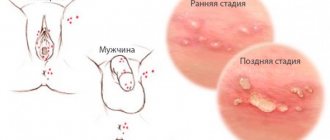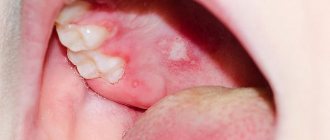Herpesvirus infections are a group of infectious diseases that are caused by viruses from the Herpesviridae family, can occur in the form of localized, generalized, recurrent forms of the disease, and have the ability to persist (the virus is constantly present) in the human body.
Herpesvirus infections (HVI) are among the most common human viral diseases. Their infection and morbidity rates are increasing every year. In all countries of the world, 60-90% of the population is infected with one or another herpes virus.
Etiology
Herpes viruses contain double-stranded DNA and have a glyco-lipoprotein envelope. The sizes of viral particles are from 120 to 220 nm.
Today, 8 types of herpes viruses that have been identified in humans have been described:
- two types of herpes simplex virus (HSV-1, HSV-2),
- varicella zoster virus (VZV or HHV-3),
- Epstein-Barr virus (EBV or HHV-4),
- cytomegalovirus (CMV or HHV-5), HHV-6, HHV-7, HHV-8.
Based on the biological properties of viruses, 3 subfamilies of herpes viruses have been formed: (alpha herpes viruses, beta herpes viruses and gamma herpes viruses). A-herpesviruses include HSV-1, HSV-2, VZV.
Betaherpesviruses include CMV, HHV-6, HHV-7. They, as a rule, multiply slowly in cells, cause an increase in the affected cells (cytomegaly), are capable of persistence, mainly in the salivary glands and kidneys, and can cause congenital infections. Gammaherpesviruses include EBV and HHV-8.
Herpes simplex virus types 1 and 2
The term “herpes infection” (HI) is usually used to refer to diseases that are caused by HSV-1 and HSV-2. The source of HSV infection are sick people with various forms of the disease, including latent ones, as well as virus carriers.
HSV-1 is transmitted by airborne droplets and contact. When the virus gets on the skin during a cough or sneeze, it is contained in droplets of saliva and survives for an hour. On wet surfaces (washbasin, bathtub, etc.) it remains viable for 3-4 hours, which is often the cause of disease outbreaks in preschool institutions. Infection can occur through kissing, as well as through household items that are infected with the saliva of a patient or virus carrier. HSV-2 is transmitted sexually or vertically. With the latter, infection occurs during childbirth (contact with the mother's birth canal), transplacentally or through the cervical canal in the uterine cavity. Due to the fact that viremia occurs during generalization of infection, transfusion or parenteral transmission of HSV-2 infection is also possible. HSV-2 usually causes genital and neonatal herpes.
Children are most susceptible to GI between 5 months and 3 years of age. Depending on the mechanism of infection, acquired and congenital forms of HI are distinguished. Acquired HI can be primary and secondary (recurrent), localized and generalized. A latent form of GI is also isolated.
No infection has such a variety of clinical manifestations as the herpes virus. It can cause damage to the eyes, nervous system, internal organs, mucous membrane of the gastrointestinal tract, oral cavity, genitals, can cause cancer, and has a certain significance in neonatal pathology and the occurrence of hypertension. The spread of the virus in the body occurs through hematogenous, lymphogenous, and neurogenic routes.
The frequency of primary herpesvirus infection increases in children after 6 months of life, when antibodies received from the mother disappear. The peak incidence occurs at the age of 2-3 years. HI often occurs in newborns; according to a number of authors, it is diagnosed in 8% of newborns with general somatic pathology and in 11% of premature infants.
According to WHO, diseases caused by the herpes simplex virus (HSV) are the second leading cause of death from viral infections after influenza. Solving the problem of diagnosing and treating herpesvirus infection with manifestations on the oral mucosa is one of the most important tasks of practical medicine.
In the last decade, the importance of herpesvirus diseases as a public health problem has been constantly growing throughout the world. Members of the human herpesvirus family infect up to 95% of the world's population.
Primary forms of GI include: infection of newborns (generalized herpes, encephalitis, herpes of the skin and mucous membranes), encephalitis, gingivostomatitis, Kaposi's eczema herpetiformis, primary herpes of the skin, eye, herpetic panaritium, keratitis. Primary HI occurs due to initial human contact with HSV. As a rule, this occurs in early childhood (up to 5 years). In adults aged 16-25 years who do not have antiviral immunity, primary HI may more often be caused by HSV-2. 80-90% of initially infected children carry the disease latently, and only in 10-20% of cases are clinical manifestations of the disease observed.
Secondary, recurrent forms of GI are herpes of the skin and mucous membranes, ophthalmic herpes, and genital herpes.
Pediatrician Mikhail Nikolsky: Herpes - to treat or not to treat
Alexandra Petrovskaya: Good afternoon. This is a program for the biggest ones. With us in the studio is pediatrician and candidate of medical sciences Mikhail Nikolsky. Mikhail Andreevich, hello.
Mikhail Nikolsky: Good afternoon.
A.P.: We have gathered here today about your scientific work on herpes types 6 and 7. Let's try to explain to the listeners what it is, and, most importantly, where these types come from, and what other types - the first, second, third and so on - go up to 6 and 7.
M.N.: In total, there are 8 or 9 types of herpes, depending on how you count. The first and second types are common herpes, which causes cold sores on the lips. The third type is the herpes zoster virus, which causes chickenpox or shingles in adults.
A.P.: So what we call chickenpox is, in fact, the same herpes?
M.N.: Not the same, it’s a completely different herpes, but also herpes.
A.P.: By what principle are they all united under this name?
M.N.: It's difficult. When scientists studied the DNA of these viruses, it turned out that they all had similar related features. The fourth type, Epstein-Barr virus, causes infectious mononucleosis. The fifth type is what everyone knows as cytomegalovirus. These are also often infections, mostly for children.
And finally, type 6 and 7 are what I do. Most often they cause roseola in children - a three-day fever or sudden exanthema. Next comes the eighth type of herpes, it occurs in Kaposi's sarcoma. This is a serious disease that predominantly occurs in HIV-infected patients.
A.P.: Besides the common name and some similarities in DNA, what else unites them? Maybe there are common methods of therapy or similar effects of the virus on the body?
M.N.: Firstly, unlike many other viruses, there is a medicine against herpes. This is what makes these viruses different from others in many ways because there are no cures for a huge number of viruses.
A.P.: What about all these fashionable antiviral drugs that are advertised everywhere?
M.N.: Everything that is advertised on TV is, unfortunately, most likely fake.
A.P.: Fakes are prohibited.
M.N.: Fakes are prohibited, but, apparently, advertising of drugs without proven effectiveness is allowed.
A.P.: This is a topic for a separate program.
M.N.: This is a problem for our country, because in our country fakes have even found their way into clinical recommendations. And we treat people with all these “bullshit drugs.” Moreover, we are obliged to treat them, because we have appropriate clinical recommendations.
A.P.: Is someone lobbying for this?
M.N.: Of course, this is lobbied for, it is paid for. And what to take if, excuse me, we have one of the members of the Russian Academy of Sciences - a homeopath.
A.P.: In these words you can feel your contempt for homeopathy.
M.N.: From the point of view of a clinical physician, to some extent, yes, contempt, this is true.
Let's return to herpes. They have a unique feature. After a person becomes ill with a primary herpes infection, these viruses do not leave the human body. All herpes that a person encounters in life remain with him forever.
A.P.: I came across the statement that it is difficult to meet a person on Earth over 10 years old who does not have antibodies to one or another type of herpes.
M.N.: And not only antibodies, but even the herpes themselves. In almost all people after a certain age, one or another herpes can be found in saliva, blood or other tissues. This is the problem with diagnosing them - doctors very often get confused. Colleagues, out of ignorance, but with the best intentions, prescribe, for example, saliva tests for frequently ill patients for the Epstein-Barr virus, cytomegalovirus, herpes type 6, type 7, and find them in the saliva. And this is the norm.
A.P.: Are they starting to treat?
M.N.: Yes, absolutely right. The patient does not know that this is the norm. He sees that he has a “terrible” test, that such and such a number of these herpes have been found, and the doctor, most likely, out of ignorance and lack of understanding of this problem, begins to treat normal carriers of herpes. And what does he treat? He treats with the same fuflomycins. And nothing happens.
A.P.: Bottom line – there is no need to treat herpes?
M.N.: It is necessary if it caused a serious illness - and all herpes in certain cases can cause serious illnesses. For example, herpes type 6 is a common cause of severe conditions in patients after a bone marrow transplant. If herpes after a bone marrow transplant has worsened against the background of a decrease, the actual destruction of one’s own immunity, then therapy necessarily requires powerful antiviral agents.
Well, take chickenpox – it would seem a harmless disease. But after 11 years it is difficult and can have consequences. Therefore, it is believed that if the patient is under 11 years of age, it often goes away on its own. And if you are over 11 years old, then it is better not to risk it, but to prescribe acyclovir.
A.P.: Is this a drug with proven effectiveness?
M.N.: Yes, it acts specifically on the chickenpox virus.
A.P.: It turns out that herpes, which is always in the body, at some point gets worse. For example, I heard about herpes type 6, that this is a typical disease for children under 2-3 years of age. It turns out that no.
M.N.: The fact is that herpes type 6 is the most common infection that always causes sudden exanthema or three-day fever or roseola. In principle, it is a very understandable infection: the child has a high fever for three days, then a typical maculopapular rash appears. Within two days it disappears on its own and the person recovers.
The infection itself can occur even through an ordinary kiss, as happens with many herpes. That is, the virus can enter the child’s body through contact with the saliva of the mother, grandmother, or any adult, who are usually the carrier of all herpes. And so the child suffers this primary infection through the human herpes virus type 6, and after that the human herpes type 6 remains in this child forever. And it won’t go anywhere, and there’s no way to get rid of it.
But it needs to be treated only in one situation - if it has caused some kind of serious illness, which almost never occurs in healthy people. Only for severe immunodeficiencies, which usually occur during organ and tissue transplantation. There are situations when intensive treatment of herpes type 6 is required.
In all other cases, there is no need to shock-treat it. And we must keep in mind that herpes is a very fashionable topic now. Herpes virus type 6 is easy to find, which means it can be presented for almost any disease as a possible diagnosis. And many doctors use this. For example: “I don’t know what’s wrong with you. Let’s look for what you definitely have.” And here is herpes type 6 - it definitely exists, and it is there.
A.P.: Another such moment. What other diseases can be associated with herpes viruses that are present in the body?
M.N.: As I already said, herpes types 6 and 7 “classically” cause roseola in children. Herpes type 6 and sometimes, but rarely, type 7 are also associated with febrile seizures in children. There are studies that show a connection between certain types of epilepsy and human herpes virus type 6. So it turns out that herpes type 6 actually causes a type of epilepsy.
A.P.: This virus is present in almost everyone’s body, but not everyone has epilepsy. That is, this suggests that there is no direct connection; there are other factors influencing the appearance of this disease?
M.N.: Of course, there are many factors here. For example, two people caught the same infection: but one had a runny nose, and the other had meningitis. But the infection is the same. Of course, there are many factors involved.
There was also a study that associated human herpes viruses 6 and 7 with other diseases, suggesting a link with multiple sclerosis. But this has not been proven. This is already a field of science, but we do not have clear indications that herpes is exactly what causes multiple sclerosis.
A.P.: During the program, we talked briefly about all herpes and outlined all the important points. And, concluding the conversation, I want to return to the beginning. What questions does science face today in this area?
M.N.: By the way, I forgot to say that a special form of human herpes type 6 is the chromosomal integrated form of this virus, when herpes type 6 is introduced into the human chromosome and begins to be inherited by all generations.
Now we have received a grant in St. Petersburg. We conduct free examinations of everyone for certain indications for the presence of chromosomally integrated human herpes type 6. It is precisely the presence of chromosomally integrated human herpes type 6 that may provide links with certain diseases. It turns out that almost 1% of the world's population has a chromosomally integrated virus built into its genome.
A.P.: Okay. Remembering my student years, what hypothesis do you have in this scientific research? If something, then what?
M.N.: We are currently recruiting a reference group, we are looking for people, we are examining them. I personally am now most interested in whether there are clinical manifestations of chromosomal integration of human herpes type 6 in newborns. In my opinion, this is the most interesting concept; no one in the world has yet developed this direction. So far there are preliminary results, but I’m not ready to announce them yet.
A.P.: Our guest was Mikhail Nikolsky, a pediatrician and candidate of medical sciences. Thank you and have a nice day everyone!
Epstein-Barr virus infection
An infectious disease caused by the Epstein-Barr virus (EBV) and characterized by a systemic lymphoproliferative process with a benign or malignant course.
EBV is isolated from the body of a patient or virus carrier with oropharyngeal secretions. Transmission of the infection occurs through airborne droplets through saliva, often when a mother kisses her child, which is why EBV infection is sometimes called the “kissing disease.” Children often become infected with EBV through toys contaminated with the saliva of a sick child or a virus carrier, when using shared utensils and linen. Blood transfusion and sexual transmission of the infection are possible. Cases of vertical transmission of EBV from mother to fetus have been described, suggesting that the virus may be the cause of intrauterine developmental anomalies. Contagiousness during EBV infection is moderate, which is probably due to the low concentration of the virus in saliva. The activation of infection is influenced by factors that reduce general and local immunity. The causative agent of EBV infection has a tropism for the lymphoid-reticular system. The virus penetrates the B-lymphoid tissues of the oropharynx and then spreads throughout the body's lymphatic system. Infection of circulating B lymphocytes occurs. The DNA virus penetrates into the nuclei of cells, while the proteins of the virus give infected B-lymphocytes the ability to continuously multiply, causing the so-called “immortality” of B-lymphocytes. This process is a characteristic feature of all forms of EBV infection.
EBV can cause: infectious mononucleosis, Burkitt's lymphoma, nasopharyngeal carcinoma, chronic active EBV infection, leiomyosarcoma, lymphoid interstitial pneumonia, hairy leukoplakia, non-Hodgkin's lymphoma, congenital EBV infection.
Herpesvirus infections in children
Normally, every person is constantly home to a huge number of viruses, fungi and bacteria. Such permanent “residents” of our body include herpes viruses.
There are several species in the herpesvirus family, and they all have one thing in common - once they get into a person, they never leave him. When examining people for infection with these viruses, it turns out that 70.4% have herpes viruses type 1-2, 97.9% have varicella zoster (varicella zoster virus), 95% have cytomegalovirus, 97.5% have herpes virus type 6 , 95% have Epstein-Barr virus.
Primary infection with herpes viruses occurs in early childhood. Sometimes the virus enters the body asymptomatically, and sometimes it is accompanied by a clinical picture characteristic of the virus. Depending on the reactivity of the body and the state of its immunity, the disease can be quite severe.
Thus, the primary acute disease caused by type 1 herpes viruses is characterized by severe damage to the oral mucosa. The child has a high temperature for several days, he refuses to eat, intoxication is severe, painful ulcers appear in the mouth, the submandibular and cervical lymph nodes become enlarged and painful. Improvement may occur only by 5-7 days, and in some children recovery may take up to 2-3 weeks. In the future, under unfavorable conditions, the virus can rear its head again (recur), but its manifestations, as a rule, are not so severe - most often these are blistering rashes on the lips, which are popularly called a “cold.”
The chickenpox virus (Varicella zoster) also belongs to the herpesvirus family.
When meeting him, the child gets chickenpox. After this, immunity to the virus is developed, a person should no longer get chickenpox a second time (repeated cases of infection are extremely rarely diagnosed), but the virus does not completely leave the body, but remains dormant in the nerve ganglia. When the immune system is weakened (usually in older people), this viral infection recurs in the form of herpes zoster. Bubble elements appear on the skin along the peripheral nerves and in half of the cases along the intercostal nerves. The rash covers the torso like a belt (the word “zoster” in Greek means belt). This condition is accompanied by severe pain - neuralgia and, sometimes, general intoxication.
Herpes virus type 6 during primary infection can cause an acute infectious disease in a child, called sudden exanthema (infantile roseola, sixth disease). First, a high temperature occurs, which lasts an average of 3 days. In most cases, there are no catarrhal symptoms, only slight redness in the throat. Then, as the temperature drops, a red spotty rash appears, which lasts 1.5-2 days and disappears. If the child also received an antibiotic, this rash may be mistakenly regarded as a drug rash. Complications are rare. When the virus enters the latent stage, it most often does not manifest itself in any way. But its involvement in some diseases (for example, chronic fatigue syndrome) is discussed.
Cytomegalovirus and Epstein Barr Virus. Most often they quietly settle into the body, but sometimes in children they manifest themselves as a disease such as Infectious mononucleosis. It can be difficult. There is prolonged high fever, generalized enlargement of the lymph nodes, and especially the lymph nodes of the neck. They grow so large that they visually deform the neck, but they hardly hurt. Other lymphoid formations, such as tonsils and adenoids, also greatly increase. Because of this, the child cannot breathe through his nose and snores at night. Plaques, most often filmy, may appear on the tonsils. The liver and spleen may become enlarged, and sometimes a rash and jaundice may appear.
After suffering any of the above infections, during examination, blood tests determine antibodies specific to the specific virus involved in the disease. Only a doctor can interpret test results. And if the antibodies are positive, this does not mean that the infection is alive, and we must continue to fight it. Most often, this is a memory of an encounter with the virus, and only a doctor can tell you whether it is still active or not.
No need to treat tests! It is necessary to treat the child if his condition requires it.
In each specific case, the doctor will prescribe treatment; sometimes hospitalization is required due to severe infection.
The parents' task is to consult a doctor in time.
And after recovery, follow certain rules so that the immune response is adequate and the infection no longer rears its head.
After an infection, the child’s immune defense remains reduced for a long time and he needs:
- avoid contact with other infectious patients, hypothermia and overheating for about 3 months;
- if necessary, medical withdrawal from vaccinations is recommended;
- It is advisable to follow an antiherpetic diet.
The anti-herpes diet is based on the ratio of two essential amino acids - arginine and lysine.
Lysine suppresses herpes viruses, arginine promotes their reproduction. Products rich in lysine: milk, curdled milk, fermented baked milk, cheese, cottage cheese, yoghurts containing live bacteria, potatoes, fish, pork, vegetables, white chicken, soybeans, lentils, brewer's yeast.
Arginine: chocolate, sugar, raisins, sesame seeds, seeds, nuts (especially peanuts), cereals, wheat bread, oranges and tangerines.
Be healthy!
about the author
- Dobrelya Ekaterina Alexandrovna
- Pediatrician, infectious disease specialist of the highest category
- All publications by the author
Varicella zoster infection
Varicella-zoster virus causes chickenpox and herpes zoster. The source of infection for chickenpox can only be a person with chickenpox or herpes zoster, including the last 24-48 hours of the incubation period. Convalescent chickenpox remains infectious for 3-5 days after the skin rash stops. The disease cannot be transmitted through a third party. Intrauterine infection with chickenpox is possible in the case of a pregnant woman. Chickenpox can occur at any age, but in modern conditions the maximum number of patients occurs in children aged 2 to 7 years. Herpes zoster develops after primary infection with the Varicella-zoster virus, after the infection passes into a latent form, in which the virus is localized in the spinal, trigeminal, sacral and other nerve ganglia. Endogenous reactivation of the infection is possible.
Cytomegalovirus infection
An infectious disease that is caused by cytomegalovirus (CMV) and is characterized by a variety of clinical forms (from asymptomatic to severe generalized with damage to many organs) and course (acute or chronic). CMV transmission factors can be almost all biological substrates and human secretions that contain the virus: blood, saliva, urine, cerebrospinal fluid, vaginal secretions, sperm, amniotic fluid, breast milk. Potential sources of infection are organs and tissues in transplantology, as well as blood and its products in transfusiology. Routes of transmission of CMV infection: airborne, sexual, vertical and parenteral.
There are congenital and acquired forms of CMV infection. Congenital CMV infection. During antenatal infection of the fetus, infection occurs predominantly transplacentally. During intrapartum infection, CMV enters the body through aspiration of infected amniotic fluid or secretions from the mother's birth canal.
In older children, acquired CMV infection occurs in a subclinical form in 99% of cases. The most common manifestation of this form of CMV infection in children over one year of age is mononucleosis-like syndrome. As a rule, a clinical picture of acute respiratory disease is observed in the form of pharyngitis, laryngitis, and bronchitis.
Infections caused by the sixth, seventh and eighth types of herpes viruses Type six herpes viruses (HHV-6) can cause erythematous and roseolous rashes (sudden exanthema), lesions of the central nervous system and bone marrow in immunocompromised children. Herpesvirus type seven (HHV-7) causes neonatal exanthema
For the diagnosis of herpes infection, cytological, immunofluorescent, serological and PCR methods are valuable. Virological testing for herpes infection reveals complement-fixing antibodies to HSV-1 or -2 in the mother's blood, fetal cord blood and amniotic fluid. PCR method. The material for testing for herpes is blood, throat swabs, the contents of blisters, ulcers, and urine.
The study of specific antibodies of various subclasses: IgM, IgG1-2, IgG3 and IgG4 to herpes viruses is important. The detection in the blood serum of children of specific immunoglobulins M, IgG3, IgG1-2 in a titer > 1:20, viral antigen and specific immune complexes with antigen indicates the severity of the infectious process (active phase), and the determination of only specific IgG4 is regarded as the latent phase of infection or carriage of maternal antibodies.
HERPETIC INFECTION
You chavoy are out of your mind!
There's a pimple on my lip!
L. Filatov
Herpes infection is not a specific disease. This is a term that unites a whole group of diseases and requires some clarification.
Viruses, like all other organisms, are divided by scientists into families, genera, and individual species. Currently, about 80 similar representatives of the herpes virus family have been discovered in nature, 7 of them isolated from humans.
These viruses, although similar to each other, cause diseases that are very different in terms of timing, clinical manifestations, and danger to the human body. By the way, we have already met three diseases - not at all similar, but they are all caused by viruses of the herpes group. These are chicken pox, sudden exanthema and infectious mononucleosis, just discussed.
The time has come to talk about a special virus, perhaps the most widespread, capable of causing a wide variety of diseases, sometimes deadly. It is called “herpes simplex virus”.
According to numerous studies, from 65 to 90% of all inhabitants of planet Earth are infected with the herpes simplex virus! Infection occurs in childhood, by contact or airborne droplets, and by the age of 6, about 80% of children already have the herpes virus in their bodies.
The virus, as it should be, penetrates inside the cells and remains there in an inactive state for life - that is, if infection with the virus has occurred, no medicine can completely get rid of it. But there seems to be nothing wrong with this - an inactive virus does not cause any particular harm. At the same time, if certain accompanying conditions occur, accompanied by a decrease in immunity (cold, other infectious disease, stress, physical fatigue, malnutrition, lack of vitamins, injury, etc.), the virus seems to wake up, begin its dirty work and cause illness .
One of the most typical manifestations of herpes simplex is a rash on the lips, more precisely at the border of the skin and the lip itself. People simply call these itchy blisters “fever.” It is easy to notice that in some people (children) these same fevers occur often, in others - very often, in others - they never occur. It all depends on immunity, on the general level of health of a particular person.
We have already written several times about the main nonspecific antiviral protein - interferon. The fact is that the body reacts differently to each virus, producing a certain amount of interferon. In the language of scientists, each virus has “individual interferonogenic activity,” and readers will forgive me for my very clever words. The particular “harmfulness” of the herpes simplex virus lies precisely in the fact that it hardly stimulates or to a very small extent stimulates the production of natural interferon. Hence the instability and insufficiency of immunity, frequent repetitions (relapses) of the disease.
“Fever” on the lips is still the flowers of the herpes simplex virus. Manifestations of the disease can be much more serious - eye damage, widespread lesions of the skin and oral mucosa (stomatitis), extensive rashes on the genitals (so-called genital herpes), pneumonia and the most terrible manifestation of infection - herpetic encephalitis - severe inflammation of the brain with unpredictable, but, as a rule, very sad consequences.
- The severity of any manifestations of herpetic infection is determined, first of all, by the state of the immune system! Once again we have to pay attention to the fact that the main method of prevention is a natural lifestyle that ensures the normal functioning of the immune system.
- Currently, there are drugs that can selectively suppress the reproduction of herpes viruses in the human body. The most famous is acyclovir (synonyms are herpevir, virolex, zovirax), and its appearance is the same revolution in medicine as the discovery of penicillin. Acyclovir is used topically, to treat rashes (ointments, creams, jellies), courses of treatment (sometimes very long) are carried out with tablets, and for herpetic encephalitis and other particularly severe variants of the disease, the drug is administered intravenously.
- Treatment of herpes infection usually involves the use of interferon. Not those well-known and relatively cheap nasal drops, but expensive and truly effective forms of interferon that are administered by injection. In addition, special medications are used that repeatedly increase the production of interferon in the body (cycloferon, neovir).
- Herpetic infection, and this is obviously curable. It is impossible, as we already understood, to completely eradicate the virus, but forgetting about its existence is quite possible. The main drawback of all methods of treating herpes infection without exception is the discrepancy between the income of our compatriots and the cost of effective medicines.
- The difficulty of treating herpes infection is not only the cost of medications. The treatment is long-term, carried out according to certain schemes that take into account the state of immunity, concomitant diseases, and the variant of infection. Parents just need to know the main thing: “herpetic little things” - like blisters on the lips - can sooner or later turn into a more serious problem, and herpes is not a sore when self-medication can lead to success. Hence the urgent need for consultation with a competent specialist and a full examination.
author Komarovsky E.O. book Child's health and the common sense of his relatives published 02/24/2010 18:40









